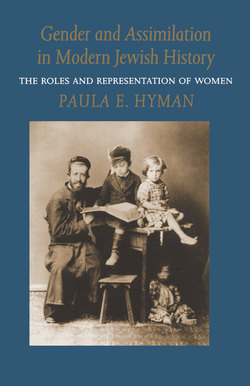Gender and Assimilation in Modern Jewish History

Реклама. ООО «ЛитРес», ИНН: 7719571260.
Оглавление
Paula E. Hyman. Gender and Assimilation in Modern Jewish History
Отрывок из книги
The Samuel & Althea Stroum Lectures
IN JEWISH STUDIES
.....
[T]o be identical with man is not the ideal of womanhood. Some things and privileges belong to him by nature; to these, true woman does not aspire; but every woman should aspire to make of her home a temple, of herself a high priestess, of her children disciples, then will she best occupy the pulpit, and her work run parallel with man’s. She may be ordained rabbi or be the president of a congregation—she is entirely able to fill both offices—but her noblest work will be at home, her highest ideal, a home.… Nothing can replace the duty of the mother in the home. Nothing can replace the reverence of children, and the children are yours to do as ye will with them.… Mothers, ye can restore Israel’s glory, can fulfil the prophecy by bringing the man-child, strong love of the Eternal, to his Maker.60
Frank’s address reflects the profound internalization of prevailing gender norms even by a woman who flouted those norms by talking from a public, rather than a domestic, pulpit. Similarly, in welcoming women in 1896 to the first convention of the National Council of Jewish Women, Rebekah Kohut, lecturer, writer, and teacher, hailed Jewish mothers’ potential as “saviors of our people.” “Every true Jewess is a priestess.… If not from our ranks, then from where shall come those who shall teach our children by religious example, and kindle within them the sparks of faith, that which will keep … ever glowing the coals of confidence in the God of Israel?”61 Only occasionally did a communal representative dissent from the exclusive emphasis on the maternal religious role. In a speech delivered at the 1893 Jewish Women’s Congress where Ray Frank had spoken, Mary Cohen, a poet, teacher, and communal activist in Philadelphia, praised the inextricable linkage of home and synagogue within Judaism and the importance of domestic ritual, including the preparation of special holiday foods. Cohen’s emphasis on the importance of “kitchen Judaism” necessarily highlighted the woman’s role. “I can never see, in the sometimes punctilious care with which some Hebrew women prepare their homes for the religious festivals, the ground for annoyance or ridicule which it seems to furnish to many critics,” she admitted. But she also referred to the shared responsibility of Jewish parents, rather than of mothers alone: “the synagogue is the home, and the home the synagogue. I mean that the intelligent and devout Hebrew parent is the priest or priestess of the family altar.”62
.....